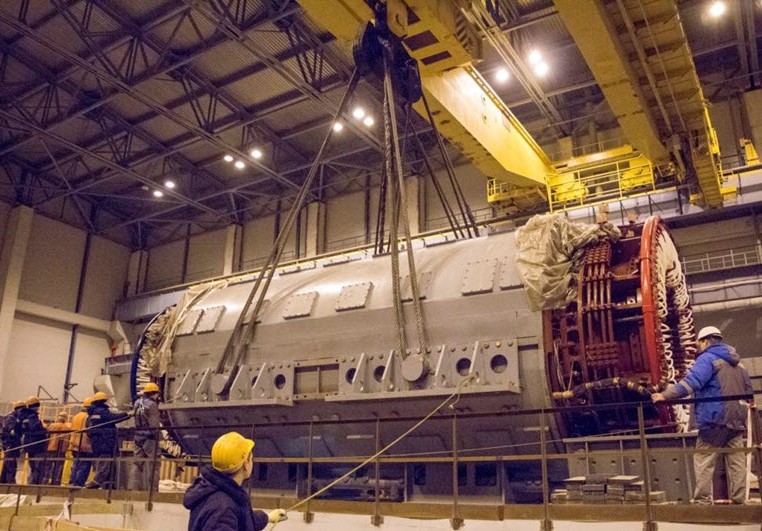
New Managing Director for Bellona Norway
The Board of the Bellona Foundation has appointed former Minister of Climate and the Environment Sveinung Rotevatn as Managing Director of Bellona No...
News

Publish date: February 13, 2017
News
A flaw in Russia’s flagship nuclear reactor line, which was originally hushed up by officials, could affect three plants Russian state corporation Rosatom is building at home and in Europe.
The flaw originally caused a short circuit in a generator at the AES-2006 reactor at the Novovoronezh plant, which took the reactor off the grid for two and a half months while the plant worked to repair it.
Rosenergoatom, Russia’s nuclear utility, originally kept the flaw under wraps until anonymous sources fed dire reports to a local newspaper, prompting the utility to go public on its website with the cause of the malfunction.
Even that cover up involved a cover up: The short circuit scrammed the reactor on November 10, but Rosenergoatom didn’t come clean about it until November 16.
The utility later backdated that report to make it look like it was published on the day of the incident apparently to stem media speculation that a serious accident had taken place.
 A view of the Novovoronezh reactor AES=2006 reactor's machine hall. (Credit: novnpp.rosenergoatom.ru)
A view of the Novovoronezh reactor AES=2006 reactor's machine hall. (Credit: novnpp.rosenergoatom.ru)
The muddy shell game of hushing the defect then obfuscating when the problem was identified makes one thing clear: The reactor is a key offering on Russia’s markets abroad and a valuable foreign policy tool to boot.
The AES-2006 reactor, also known as the VVER-1200, is under construction at the Belarus Nuclear Power Plant and the Leningrad Nuclear Power Plant II. Further afield, Finland is building one. Turkey has ordered four and Bangladesh and Hungary are in line to build two each.
The problem at the AES-2006 at Novovoronezh turned out to be a defect in the so-called stator winding mechanism, which plays a role in cooling the reactor. Initially presented by a Rosenergoatom spokesman as a relatively minor fix, it was serious enough for technicians to altogether replace the part in the plant’s second AES-2006 reactor.
The company that makes the generator, St. Petersburg’s Power Machines, said it had done the repairs at the Novovoronezh AES-2006 reactors, and further added it would undertake “modernization” of the same generator line installed in the AES-2006 reactors at the Belarus Nuclear Power Plant, as well as at the Leningrad Nuclear Power Station II.
The rush to get the AES-2006 out the door – and gag any screw-ups along the way – was predictable. With fluctuating oil and gas prices, nuclear energy, specifically the new reactor, is another foothold for Moscow in the European energy market.
Lateral moves between president Vladimir Putin’s administration and Rosatom brass make clear the role nuclear energy plays in state policy.
In October, Sergei Kiriyenko moved from Rosatom to the become deputy head of Putin’s administration. He was replaced by Aleskei Likhachev, an economics minster. Likhachev has since made it his business to cheer lead for the AES -2006 reactor.
Earlier this month, Putin himself went to Hungary to push Rosatom’s controversial deal to build two AES-2006 reactors at the country’s €12 billion PAKS II Nuclear Power Plant. The European Union, thanks to lobbying by France and the United Kingdom, seems ready to green light the reactor construction, nudging the door to Europe’s nuclear market open for Rosatom.
Russia has a habit of conducting foreign policy by choking, then reviving, natural gas supplies to the EU. Disputes between Russia and Ukraine, which remain bitter, led to cuts in Europe’s gas supply from Russia in 2006 and 2009. This drove Europe to diversify just whom it was depending on for its winter heat.
But locking into Russia’s start-to-finish nuclear deals, beginning with Finland and with Hungary, is a big step back toward dependence on Moscow.
To build its two AES-2006s Hungary would take a loan from Russia to finance 80 percent of the project and putting it in hock to Moscow for decades. Rosatom would also effectively operate the plant for 50 years, supplying it with all of its fuel and much of its technical know-how.
Such dependence has had scary side effects when a country finds itself on Moscow’s bad side.
In 2014, at the height of EU-Russia tensions over Moscow’s annexation of Crimea, Kremlin officials threatened to cut nuclear fuel supplies to Ukraine’s Soviet built reactors, raising the specter of Moscow forcing a calamitous nuclear accident.
Kiriyenko eventually walked that back, but the lurid message in Moscow’s head-fake at igniting a second Chernobyl was clear: Russian-built reactors are a useful form of post-Cold War nuclear blackmail.
It is, of course, unlikely that the Kremlin wants a meltdown so close to its own borders. It’s dealt with such hassles before.
But the EU might want to think about how much it wants to depend on Moscow to keep it safe. The AES-2006 has only been in commercial operation for a year and the generator short circuit might be only the first of its problems.
If the EU finds itself in another tense argument with Moscow over Crimea – or anything else – it could find the AES-2006 repair hotline temporarily disconnected.
Andrei Ozharovsky contributed to this report.

The Board of the Bellona Foundation has appointed former Minister of Climate and the Environment Sveinung Rotevatn as Managing Director of Bellona No...

Økokrim, Norway’s authority for investigating and prosecuting economic and environmental crime, has imposed a record fine on Equinor following a comp...

Our op-ed originally appeared in The Moscow Times. For more than three decades, Russia has been burdened with the remains of the Soviet ...

The United Nation’s COP30 global climate negotiations in Belém, Brazil ended this weekend with a watered-down resolution that failed to halt deforest...